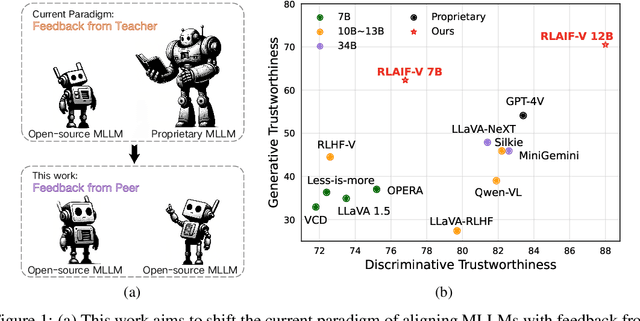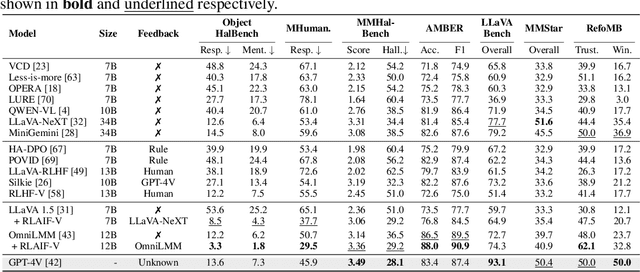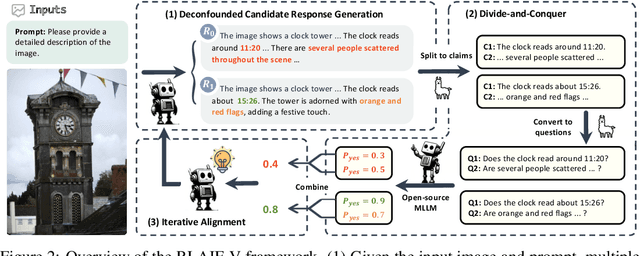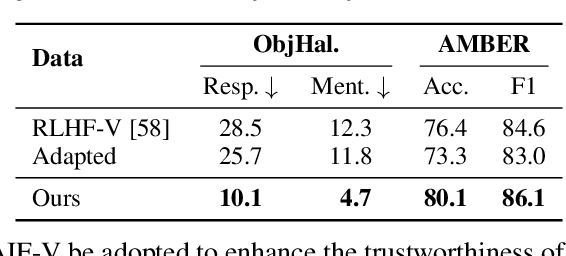Ganqu Cui
AIR: A Systematic Analysis of Annotations, Instructions, and Response Pairs in Preference Dataset
Apr 04, 2025Abstract:Preference learning is critical for aligning large language models (LLMs) with human values, yet its success hinges on high-quality datasets comprising three core components: Preference \textbf{A}nnotations, \textbf{I}nstructions, and \textbf{R}esponse Pairs. Current approaches conflate these components, obscuring their individual impacts and hindering systematic optimization. In this work, we propose \textbf{AIR}, a component-wise analysis framework that systematically isolates and optimizes each component while evaluating their synergistic effects. Through rigorous experimentation, AIR reveals actionable principles: annotation simplicity (point-wise generative scoring), instruction inference stability (variance-based filtering across LLMs), and response pair quality (moderate margins + high absolute scores). When combined, these principles yield +5.3 average gains over baseline method, even with only 14k high-quality pairs. Our work shifts preference dataset design from ad hoc scaling to component-aware optimization, offering a blueprint for efficient, reproducible alignment.
A Survey of Efficient Reasoning for Large Reasoning Models: Language, Multimodality, and Beyond
Mar 27, 2025Abstract:Recent Large Reasoning Models (LRMs), such as DeepSeek-R1 and OpenAI o1, have demonstrated strong performance gains by scaling up the length of Chain-of-Thought (CoT) reasoning during inference. However, a growing concern lies in their tendency to produce excessively long reasoning traces, which are often filled with redundant content (e.g., repeated definitions), over-analysis of simple problems, and superficial exploration of multiple reasoning paths for harder tasks. This inefficiency introduces significant challenges for training, inference, and real-world deployment (e.g., in agent-based systems), where token economy is critical. In this survey, we provide a comprehensive overview of recent efforts aimed at improving reasoning efficiency in LRMs, with a particular focus on the unique challenges that arise in this new paradigm. We identify common patterns of inefficiency, examine methods proposed across the LRM lifecycle, i.e., from pretraining to inference, and discuss promising future directions for research. To support ongoing development, we also maintain a real-time GitHub repository tracking recent progress in the field. We hope this survey serves as a foundation for further exploration and inspires innovation in this rapidly evolving area.
UltraIF: Advancing Instruction Following from the Wild
Feb 06, 2025



Abstract:Instruction-following made modern large language models (LLMs) helpful assistants. However, the key to taming LLMs on complex instructions remains mysterious, for that there are huge gaps between models trained by open-source community and those trained by leading companies. To bridge the gap, we propose a simple and scalable approach UltraIF for building LLMs that can follow complex instructions with open-source data. UltraIF first decomposes real-world user prompts into simpler queries, constraints, and corresponding evaluation questions for the constraints. Then, we train an UltraComposer to compose constraint-associated prompts with evaluation questions. This prompt composer allows us to synthesize complicated instructions as well as filter responses with evaluation questions. In our experiment, for the first time, we successfully align LLaMA-3.1-8B-Base to catch up with its instruct version on 5 instruction-following benchmarks without any benchmark information, using only 8B model as response generator and evaluator. The aligned model also achieved competitive scores on other benchmarks. Moreover, we also show that UltraIF could further improve LLaMA-3.1-8B-Instruct through self-alignment, motivating broader use cases for the method. Our code will be available at https://github.com/kkk-an/UltraIF.
Process Reinforcement through Implicit Rewards
Feb 03, 2025Abstract:Dense process rewards have proven a more effective alternative to the sparse outcome-level rewards in the inference-time scaling of large language models (LLMs), particularly in tasks requiring complex multi-step reasoning. While dense rewards also offer an appealing choice for the reinforcement learning (RL) of LLMs since their fine-grained rewards have the potential to address some inherent issues of outcome rewards, such as training efficiency and credit assignment, this potential remains largely unrealized. This can be primarily attributed to the challenges of training process reward models (PRMs) online, where collecting high-quality process labels is prohibitively expensive, making them particularly vulnerable to reward hacking. To address these challenges, we propose PRIME (Process Reinforcement through IMplicit rEwards), which enables online PRM updates using only policy rollouts and outcome labels through implict process rewards. PRIME combines well with various advantage functions and forgoes the dedicated reward model training phrase that existing approaches require, substantially reducing the development overhead. We demonstrate PRIME's effectiveness on competitional math and coding. Starting from Qwen2.5-Math-7B-Base, PRIME achieves a 15.1% average improvement across several key reasoning benchmarks over the SFT model. Notably, our resulting model, Eurus-2-7B-PRIME, surpasses Qwen2.5-Math-7B-Instruct on seven reasoning benchmarks with 10% of its training data.
From Drafts to Answers: Unlocking LLM Potential via Aggregation Fine-Tuning
Jan 21, 2025Abstract:Scaling data and model size has been proven effective for boosting the performance of large language models. In addition to training-time scaling, recent studies have revealed that increasing test-time computational resources can further improve performance. In this work, we introduce Aggregation Fine-Tuning (AFT), a supervised finetuning paradigm where the model learns to synthesize multiple draft responses, referred to as proposals, into a single, refined answer, termed aggregation. At inference time, a propose-and-aggregate strategy further boosts performance by iteratively generating proposals and aggregating them. Empirical evaluations on benchmark datasets show that AFT-trained models substantially outperform standard SFT. Notably, an AFT model, fine-tuned from Llama3.1-8B-Base with only 64k data, achieves a 41.3% LC win rate on AlpacaEval 2, surpassing significantly larger LLMs such as Llama3.1-405B-Instruct and GPT4. By combining sequential refinement and parallel sampling, the propose-and-aggregate framework scales inference-time computation in a flexible manner. Overall, These findings position AFT as a promising approach to unlocking additional capabilities of LLMs without resorting to increasing data volume or model size.
Free Process Rewards without Process Labels
Dec 02, 2024



Abstract:Different from its counterpart outcome reward models (ORMs), which evaluate the entire responses, a process reward model (PRM) scores a reasoning trajectory step by step, providing denser and more fine grained rewards. However, training a PRM requires labels annotated at every intermediate step, presenting significant challenges for both manual and automatic data collection. This paper aims to address this challenge. Both theoretically and empirically, we show that an \textit{implicit PRM} can be obtained at no additional cost, by simply training an ORM on the cheaper response-level labels. The only assumption is to parameterize the outcome reward as the log-likelihood ratios of the policy and reference models, which can be optimized regardless of the specific choice of loss objectives. In experiments, we instantiate our implicit PRMs with various objectives and evaluate their performance on MATH. We show that our implicit PRM outperforms a strong MCTS-based baseline \textit{\'a la} Math-Shepherd using less than $1/38$ of the training data. Its performance can be further improved with majority voting. We further find that scaling up instructions and responses benefits our implicit PRM, and the latter brings a larger gain. Particularly, we find that our implicit PRM, when instantiated with the cross-entropy (CE) loss, is more data-efficient and can keep improving generation models even when trained with only one response per instruction, the setup that suffers from extreme data scarcity and imbalance. Further, instructions should be relevant to downstream tasks while the diversity of responses does not bring gains. Surprisingly, training on extra Math-Shepherd step labels brings no further improvements to our implicit PRM trained on only outcome data. We hope that our work will encourage a rethinking of PRM training approaches and contribute to making training PRMs more accessible.
Scalable Efficient Training of Large Language Models with Low-dimensional Projected Attention
Nov 04, 2024



Abstract:Improving the effectiveness and efficiency of large language models (LLMs) simultaneously is a critical yet challenging research goal. In this paper, we find that low-rank pre-training, normally considered as efficient methods that will compromise performance, can be scalably effective when reduced parameters are precisely targeted. Specifically, applying the low-dimensional module only to the attention layer -- resolves this issue and enhances both effectiveness and efficiency. We refer to this structure as Low-dimensional Projected Attention (LPA) and provide an explanatory analysis. Through extensive experimentation at parameter scales of 130M, 370M, and scaling up to 3B, we have validated the effectiveness and scalability of LPA. Our results show that LPA model can save up to 12.4% in time while achieving an approximate 5% improvement in test perplexity (ppl) and on downstream tasks compared with the vanilla Transformer.
Zero-Shot Generalization during Instruction Tuning: Insights from Similarity and Granularity
Jun 17, 2024



Abstract:Understanding alignment techniques begins with comprehending zero-shot generalization brought by instruction tuning, but little of the mechanism has been understood. Existing work has largely been confined to the task level, without considering that tasks are artificially defined and, to LLMs, merely consist of tokens and representations. This line of research has been limited to examining transfer between tasks from a task-pair perspective, with few studies focusing on understanding zero-shot generalization from the perspective of the data itself. To bridge this gap, we first demonstrate through multiple metrics that zero-shot generalization during instruction tuning happens very early. Next, we investigate the facilitation of zero-shot generalization from both data similarity and granularity perspectives, confirming that encountering highly similar and fine-grained training data earlier during instruction tuning, without the constraints of defined "tasks", enables better generalization. Finally, we propose a more grounded training data arrangement method, Test-centric Multi-turn Arrangement, and show its effectiveness in promoting continual learning and further loss reduction. For the first time, we show that zero-shot generalization during instruction tuning is a form of similarity-based generalization between training and test data at the instance level. We hope our analysis will advance the understanding of zero-shot generalization during instruction tuning and contribute to the development of more aligned LLMs. Our code is released at https://github.com/HBX-hbx/dynamics_of_zero-shot_generalization.
UltraMedical: Building Specialized Generalists in Biomedicine
Jun 06, 2024Abstract:Large Language Models (LLMs) have demonstrated remarkable capabilities across various domains and are moving towards more specialized areas. Recent advanced proprietary models such as GPT-4 and Gemini have achieved significant advancements in biomedicine, which have also raised privacy and security challenges. The construction of specialized generalists hinges largely on high-quality datasets, enhanced by techniques like supervised fine-tuning and reinforcement learning from human or AI feedback, and direct preference optimization. However, these leading technologies (e.g., preference learning) are still significantly limited in the open source community due to the scarcity of specialized data. In this paper, we present the UltraMedical collections, which consist of high-quality manual and synthetic datasets in the biomedicine domain, featuring preference annotations across multiple advanced LLMs. By utilizing these datasets, we fine-tune a suite of specialized medical models based on Llama-3 series, demonstrating breathtaking capabilities across various medical benchmarks. Moreover, we develop powerful reward models skilled in biomedical and general reward benchmark, enhancing further online preference learning within the biomedical LLM community.
RLAIF-V: Aligning MLLMs through Open-Source AI Feedback for Super GPT-4V Trustworthiness
May 27, 2024



Abstract:Learning from feedback reduces the hallucination of multimodal large language models (MLLMs) by aligning them with human preferences. While traditional methods rely on labor-intensive and time-consuming manual labeling, recent approaches employing models as automatic labelers have shown promising results without human intervention. However, these methods heavily rely on costly proprietary models like GPT-4V, resulting in scalability issues. Moreover, this paradigm essentially distills the proprietary models to provide a temporary solution to quickly bridge the performance gap. As this gap continues to shrink, the community is soon facing the essential challenge of aligning MLLMs using labeler models of comparable capability. In this work, we introduce RLAIF-V, a novel framework that aligns MLLMs in a fully open-source paradigm for super GPT-4V trustworthiness. RLAIF-V maximally exploits the open-source feedback from two perspectives, including high-quality feedback data and online feedback learning algorithm. Extensive experiments on seven benchmarks in both automatic and human evaluation show that RLAIF-V substantially enhances the trustworthiness of models without sacrificing performance on other tasks. Using a 34B model as labeler, RLAIF-V 7B model reduces object hallucination by 82.9\% and overall hallucination by 42.1\%, outperforming the labeler model. Remarkably, RLAIF-V also reveals the self-alignment potential of open-source MLLMs, where a 12B model can learn from the feedback of itself to achieve less than 29.5\% overall hallucination rate, surpassing GPT-4V (45.9\%) by a large margin. The results shed light on a promising route to enhance the efficacy of leading-edge MLLMs.
 Add to Chrome
Add to Chrome Add to Firefox
Add to Firefox Add to Edge
Add to Edge